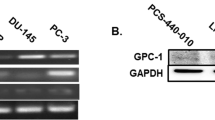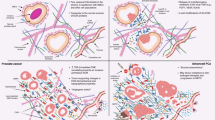Abstract
The paracrine influence of prostatic stroma on the proliferation of prostatic epithelial cells was investigated. Using a double-layer soft agar assay it was demonstrated that stromal cells from the human prostate inhibit the anchorage-independent growth of the prostatic tumor epithelial cell lines PC-3 and LNCaP. Anchorage-dependent growth was inhibited too as was shown in the semi-automated colorimetric MTT test performed on multiwell plates. Antiproliferative activity was mediated by a diffusible factor in the stromal cell conditioned medium and was found to be produced specifically by prostatic stromal cells. Although the putative inhibiting factor shared some properties with transforming growth factor beta (TGF-ß) evidence is presented that the factor is different from this well-known inhibitor of epithelial cell growth. Absence of TGF-ß activity was shown by the lack of inhibitory response of the TGF-ß-sensitive mink lung cell line CCL-64 to prostate stromal cell conditioned medium and to concentrated partially purified preparations of the inhibitor. Furthermore, neutralizing antibodies against TGF-ß1 or TGF-ß2 did not cause a decline in the level of PC-3 growth inhibition caused by partially purified inhibitor. It is concluded that the prostate stroma-derived factor may be a novel growth inhibitor different from any of the currently described inhibiting factors.
Similar content being viewed by others
References
Barnard JA, Lyons RM, Moses HL (1990) The cell biology of transforming growth factor beta. Biochim Biophys Acta 1032:79
Chang S, Chung LW (1989) Interaction between prostatic fibroblast and epithelial cells in culture: role of androgen. Endocrinology 125:2719
Childs ChB, Proper JA, Tucker RF, Moses HL (1982) Serum contains a platelet-derived transforming growth factor. Proc Natl Acad Sci USA 79:5312
Chung LWK, Cunha GR (1983) Stromal-epithelial interactions II. Regulation of prostatic growth by embryonic urogenital sinus mesenchyme. Prostate 4:503
Chung LW, Zhau HE, Ro JY (1990) Morphologic and biochemical alterations in rat prostatic tumors induced by fetal urogenital sinus mesenchyme. Prostate 17:165
Cunha GR, Chung LWK, Shannon JM, Reese BA (1980) Stromal-epithelial interactions in sex differentiation. Biol Reprod 22:19
Cunha GR, Chung LWK, Shannon JM, Taguchi O, Fujii H (1983) Hormone-induced morphogenesis and growth: role of mesenchymal-epithelial interactions. Recent Prog Horm Res 39:559
Cunha GR, Donjacour AA, Cooke PS, Mee S, Bigsby RM, Higgins SJ, Sugimura Y (1987) The endocrinology and developmental biology of the prostate. Endocr Rev 8:338
Danielpour D, Dart LL, Flanders KC, Roberts AB, Sporn MB (1989) Immunodetection and quantitation of the two forms of transforming growth factor-beta (TGF-ß1 and TGF-ß2) secreted by cells in culture. J Cell Physiol 138:79
DeCosse JJ, Gossens CL, Kuzma JF (1973) Breast cancer. Induction of differentiation by embryonic tissue. Science 181:1057
Deshpande N, Hallowes RC, Cox S, Mitchell I, Hayward S, Towler JM (1989) Divergent effects of interferons on the growth of human benign prostatic hyperplasia cells in primary culture. J Urol 141:157
Dixon M (1953) A nomogram for ammonium sulphate solutions. Biochem J 54:457
Djakiew D, Delsite R, Pflug B, Wrathall J, Lynch JH, Onoda M (1991) Regulation of growth by a nerve growth factor-like protein which modulates paracrine interactions between a neoplastic epithelial cell line and stromal cells of the human prostate. Cancer Res 51:3304
van den Eijnden-van Raaij AJ, Koornneef I, Slager HG, Mummery CL, van Zoelen EJ (1990) Characterization of polyclonal anti-peptide antibodies specific for transforming growth factor beta 2. J Immunol Methods 133:107
Fong CJ, Sherwood ER, Braun EJ, Berg LA, Lee C, Kozlowski JM (1992) Regulation of prostatic carcinoma cell proliferation and secretory activity by extracellular matrix and stromal secretions. Prostate 21:121
Franks LM, Riddle PN, Carbonell AW, Gey GO (1970) A comparative study of the ultrastructure and lack of growth capacity of adult human prostate epithelium mechanically separated from its stroma. J Pathol 100:113
Goldstein D, O'Leary M, Mitchen J, Borden EC, Wilding G (1991) Effects of interferon βser and transforming growth factor β on prostatic cell lines. J Urol 146:1173
Graycar JL, Miller DA, Arrick BA, Lyons RM, Moses HL, Derynck R (1989) Human transforming growth factor-beta 3: recombinant expression, purification, and biological activities in comparison with transforming growth factors-beta 1 and -beta 2. Mol Endocrinol 3:1977
Hayashi N, Cunha GR (1991) Mesenchyme-induced changes in the neoplastic characteristics of the Dunning prostatic adenocarcinoma. Cancer Res 51:4924
Hebert CD, Birnbaum LS (1989) Lack of correlation between sensitivity to growth inhibition and receptor number for transforming growth factor beta in human squamous carcinoma cell lines. Cancer Res 49:3196
Holley RW, Armour R, Baldwin JH (1983) Activity of a kidney epithelial cell growth inhibitor on lung and mammary cells. Cell Biol Int Rep 7:141
Ikeda T, Lioubin MN, Marquardt H (1987) Human transforming growth factor type beta 2: production by a prostatic adenocarcinoma cell line, purification, and initial characterization. Biochemistry 26:2406
Imanishi J, Hoshino S, Matsuoka H, Uemura H, Imanishi T, Tanaka A, Nishino H, Kishida T (1983) Tumor degeneration by human embryonic fibroblasts and its enhancement by interferon. Cancer Res 43:4323
Isaacs JT (1984) Antagonistic effect of androgen on prostatic cell death. Prostate 5:545
Kabalin JN, Peehl DM, Stamey TA (1989) Clonal growth of human prostatic epithelial cells is stimulated by fibroblasts. Prostate 14:251
Kirk D, Szalay MF, Kaighn ME (1981) Modulation of growth of a human prostatic cancer cell line (PC-3) in agar culture by normal human lung fibroblasts. Cancer Res 41:1100
Knabbe C, Lippman ME, Wakefield LM, Flanders KC, Kasid A, Derynck R, Dickson RB (1987) Evidence that transforming growth factor-ß is a hormonally regulated negative growth factor in human breast cancer cells. Cell 48:417
Kooistra A (1991) Stromal-epithelial interactions in the prostate and its relation to steroid hormones. In: Berns PMJJ, Romijn JC, Schöder FH (eds) Mechanisms of progression to hormone-independent growth of breast and prostatic cancer. Parthenon Publishing Group, New Jersey, pp 29
Kooistra A, König JJ, Romijn JC, Schröder FH (1991) Negative control of epithelial cell proliferation by prostatic stroma. Anticancer Res 11:1495
Kooistra A, König JJ, Keizer DM, Romijn JC, Schröder FH (1995) Inhibition of prostatic epithelial cell proliferation by a factor secreted specifically by prostatic stroma. Prostate 26:123
Kooistra A, Elissen NMJ, König JJ, Vermey M, van der Kwast ThH, Romijn JN, Schröder FH (1995) Immunocytochemical characterization of explant cultures of human prostatic stromal cells. Prostate 27:42
Kooistra A, van den Eijnden-van Raaij JM, Klaij IA, Romijn JC, Schröder FH (1995) Stromal inhibition of prostatic epithelial cell proliferation not mediated by transforming growth factor ß. Br J Cancer 72:427
Kyprianou N, Isaacs JT (1989) Expression of transforming growth factor-beta in the rat ventral prostate during castration-induced programmed cell death. Mol Endocrinol 3:1515
Lawrence DA, Pitcher R, Jullien P (1985) Conversion of a high molecular weight latent beta-TGF from chicken embryofibroblasts into a low molecular weight active beta-TGF under acidic conditions. Biochem Biophys Res Commun 133:1026
Lee C (1996) Role of androgen in prostate growth and regression: stromal-epithelial interaction. Prostate (suppl) 6:42
Limonta P, Dondi D, Moretti RM, Maggi R, Motta M (1992) Antiproliferative effects of luteinizing hormone-releasing hormone agonists on the human prostatic cancer cell line LNCaP. J Clin Endocrinol Metab 75:207
Massague J (1987) The TGF-beta family of growth and differentiation factors. Cell 49:437
McKeehan WL, Adams PS, Rosser MP (1984) Direct mitogenic effects of insulin, epidermal growth factor, glucocorticoid, cholera toxin, unknown pituitary factors and possibly prolactin, but not androgen, on normal rat prostate epithelial cells in serum-free, primary cell culture. Cancer Res 44:1998
McKeehan WL, Adams PS, Fast D (1987) Different hormonal requirements for androgen-independent growth of normal and tumor epithelial cells from rat prostate. In Vitro Cell Dev Biol 23:147
Merz VW, Arnold AM, Studer UE (1994) Differential expression of transforming growth factor-beta 1 and beta 3 as well as c-fos mRNA in normal prostate, benign prostatic hyperplasia and prostate cancer. World J Urol 12:96
Nishi N, Matuo Y, Nakamoto T, Wada F (1988) Proliferation of epithelial cells derived from rat dorsolateral prostate in serum-free primary cell culture and their response to androgen. In Vitro Cell Dev Biol 24:778
Okutani T, Nishi N, Kagawa Y, Takasuga H, Takenaka I, Usui T, Wada F (1991) Role of cyclic AMP and polypeptide growth regulators in growth inhibition by interferon in PC-3 cells. Prostate 18:73
Pechl DM (1996) Cellular biology of prostatic growth factors. Prostate (Suppl) 6:74
Peebl DM, Stamey TA (1986) Serum-free growth of adult human prostatic epithelial cells. In Vitro Cell Dev Biol 22:82
Romijn JC, Verkoelen CF, Schröder FH (1988) Application of the MTT assay to human prostate cancer cell lines in vitro: establishment of test conditions and assessment of hormonestimulated growth and drug-induced cytostatic and cytotoxic effects. Prostate 12:99
Rowley DR (1992) Glucocorticoid regulation of transforming growth factor-ß activation in urogenital sinus mesenchymal cells. Endocrinology 131:471
Rowley DR (1992) Characterization of a fetal urogenital sinus mesenchymal cell line U4F: secretion of a negative growth regulatory activity. In Vitro Cell Dev Biol 28A:29
Rowley DR, Tindall DJ (1987) Responses of NBT-II bladder carcinoma cells to conditioned medium from normal fetal urogenital sinus. Cancer Res 47:2955
Rowley DR, Dang TD, Larsen M, Gerdes MJ, McBride L, Lu B (1995) Purification of a novel protein (ps20) from urogenital sinus mesenchymal cells with growth inhibitory properties in vitro. J Biol Chem 270:22058
Schuurmans ALG, Bolt J, Mulder E (1988) Androgens and TGF-ß modulate the growth response to EGF in human prostate tumor cells (LNCaP). Mol Cell Endocrinol 60:101
Sherwood ER, Fike WE, Kozlowski JM, Lee C (1988) Stimulation of human epithelial cell growth by stromal cell secretory products. Biol Reprod Suppl 38:86 (abstract)
Sherwood ER, Fong CJ, Lee C, Kozlowski JM (1992) Basic fibroblast growth factor: a potential mediator of stromal growth in the human prostate. Endocrinology 130:2955
Shirasuna K, Morioka S, Watatani K, Hayashido Y, Furusawa H, Sugiyama M, Okura M, Matsuya T (1988) Growth inhibition and differentiation of human salivary adenocarcinoma cells by medium conditioned with normal human fibroblasts. Cancer Res 48:2719
Smith RC, Litwin MS, Lu Y, Zetter BR (1995) Identification of an endogenous inhibitor of prostatic carcinoma cell growth. Nature Med 1:1040
Smithers D (1983) On some general concepts in oncology with special reference to Hodgkin's disease. Int J Radiat Oncol Biol Phys 9:731
Story MT, Livingston B, Baeten L, Swartz SJ, Jacobs SC, Begun FP, Lawson RK (1989) Cultured human prostate-derived fibroblasts produce a factor that stimulates their growth with properties indistinguishable from b-FGF. Prostate 15:355
Sugimura Y, Norman JT, Cunha GR, Shannon JM (1985) Regional differences in the inductive activity of the mesenchyme of the embryonic mouse urogenital sinus. Prostate 7:253
Sugimura Y, Cunha GR, Donjacour AA, Bigsby RM, Brody JR (1986) Whole-mount autoradiography study of DNA synthetic activity during postnatal development and androgen-induced regeneration in the mouse prostate. Biol Reprod 34:985
Truong LD, Kadmon D, McCune BK, Flanders KC, Scardino PT, Thompson TC (1993) Association of transforming growth factor-ß1 with prostate cancer: an immunohistochemical study. Hum Pathol 24:4
Vileek J, Kohase M, Henriksen-deStefano D (1987) Mitogenic effect of double-stranded RNA in human fibroblasts: role of autogenous interferon. J Cell Physiol 130:37
Wilding G (1991) Response of prostate cancer cells to peptide growth factors: transforming growth factor-beta. Cancer Surv 11:147
Wilding G, Zugmeier G, Knabbe C, Flanders K, Gelmann E (1989) Differential effects of transforming growth factor beta on human prostate cancer cells in vitro. Mol Cell Endocrinol 62:79
Wu KF, Pope JH, Ellem KA (1985) Inhibition of growth of certain human tumour cell lines by a factor derived from human fibroblast-like cell lines. I. Demonstration by mixed culture and by use of cell washings. Int J Cancer 35:477
Yan G, Fukabori Y, Nikolaropoulos S, Wang F, McKeehan WL (1992) Heparin-binding keratinocyte growth factor is a candidate stromal to epithelial cell andromedin. Mol Endocrinol 6:2123
Author information
Authors and Affiliations
Rights and permissions
About this article
Cite this article
Kooistra, A., Romijn, J.C. & Schröder, F.H. Stromal inhibition of epithelial cell growth in the prostate; overview of an experimental study. Urol. Res. 25 (Suppl 2), S97–S105 (1997). https://doi.org/10.1007/BF00941995
Received:
Accepted:
Issue Date:
DOI: https://doi.org/10.1007/BF00941995




